Using Discriminative Methods to Learn Fashion Compatibility Across Datasets
Jun 17, 2019Kedan Li, Chen Liu, Ranjitha Kumar, David Forsyth




Determining whether a pair of garments are compatible with each other is a challenging matching problem. Past works explored various embedding methods for learning such a relationship. This paper introduces using discriminative methods to learn compatibility, by formulating the task as a simple binary classification problem. We evaluate our approach using an established dataset of outfits created by non-experts and demonstrated an improvement of ~2.5% on established metrics over the state-of-the-art method. We introduce three new datasets of professionally curated outfits and show the consistent performance of our approach on expert-curated datasets. To facilitate comparing across outfit datasets, we propose a new metric which, unlike previously used metrics, is not biased by the average size of outfits. We also demonstrate that compatibility between two types of items can be query indirectly, and such query strategy yield improvements.
Why do These Match? Explaining the Behavior of Image Similarity Models
May 26, 2019Bryan A. Plummer, Mariya I. Vasileva, Vitali Petsiuk, Kate Saenko, David Forsyth




Explaining a deep learning model can help users understand its behavior and allow researchers to discern its shortcomings. Recent work has primarily focused on explaining models for tasks like image classification or visual question answering. In this paper, we introduce an explanation approach for image similarity models, where a model's output is a semantic feature representation rather than a classification. In this task, an explanation depends on both of the input images, so standard methods do not apply. We propose an explanation method that pairs a saliency map identifying important image regions with an attribute that best explains the match. We find that our explanations are more human-interpretable than saliency maps alone, and can also improve performance on the classic task of attribute recognition. The ability of our approach to generalize is demonstrated on two datasets from very different domains, Polyvore Outfits and Animals with Attributes 2.
Max-Sliced Wasserstein Distance and its use for GANs
Apr 11, 2019Ishan Deshpande, Yuan-Ting Hu, Ruoyu Sun, Ayis Pyrros, Nasir Siddiqui, Sanmi Koyejo, Zhizhen Zhao, David Forsyth, Alexander Schwing


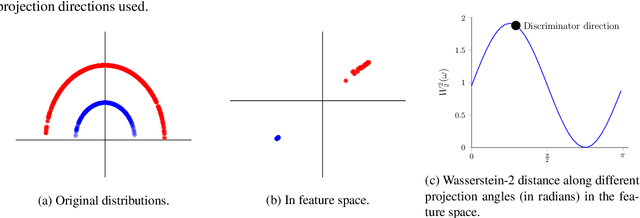
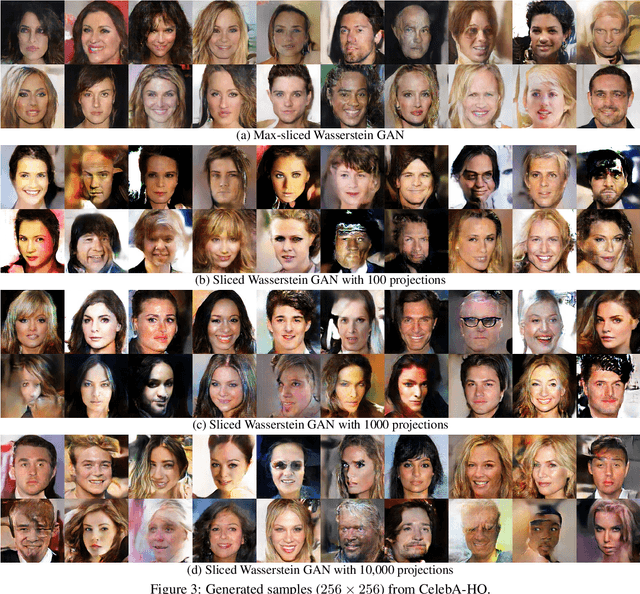
Generative adversarial nets (GANs) and variational auto-encoders have significantly improved our distribution modeling capabilities, showing promise for dataset augmentation, image-to-image translation and feature learning. However, to model high-dimensional distributions, sequential training and stacked architectures are common, increasing the number of tunable hyper-parameters as well as the training time. Nonetheless, the sample complexity of the distance metrics remains one of the factors affecting GAN training. We first show that the recently proposed sliced Wasserstein distance has compelling sample complexity properties when compared to the Wasserstein distance. To further improve the sliced Wasserstein distance we then analyze its `projection complexity' and develop the max-sliced Wasserstein distance which enjoys compelling sample complexity while reducing projection complexity, albeit necessitating a max estimation. We finally illustrate that the proposed distance trains GANs on high-dimensional images up to a resolution of 256x256 easily.
Structural Consistency and Controllability for Diverse Colorization
Sep 06, 2018Safa Messaoud, David Forsyth, Alexander G. Schwing
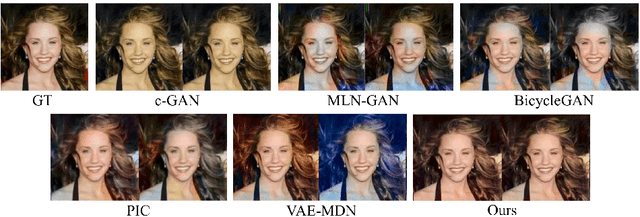

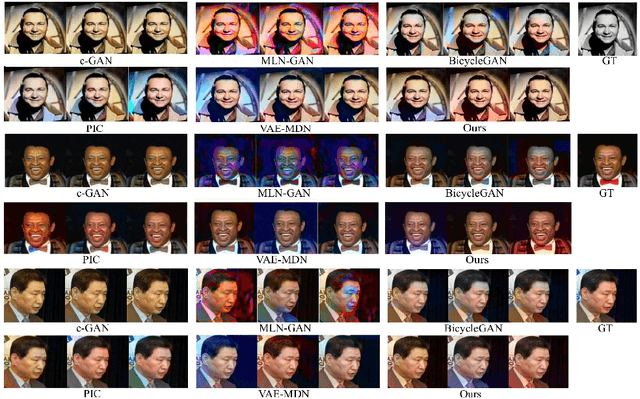

Colorizing a given gray-level image is an important task in the media and advertising industry. Due to the ambiguity inherent to colorization (many shades are often plausible), recent approaches started to explicitly model diversity. However, one of the most obvious artifacts, structural inconsistency, is rarely considered by existing methods which predict chrominance independently for every pixel. To address this issue, we develop a conditional random field based variational auto-encoder formulation which is able to achieve diversity while taking into account structural consistency. Moreover, we introduce a controllability mecha- nism that can incorporate external constraints from diverse sources in- cluding a user interface. Compared to existing baselines, we demonstrate that our method obtains more diverse and globally consistent coloriza- tions on the LFW, LSUN-Church and ILSVRC-2015 datasets.
Learning Type-Aware Embeddings for Fashion Compatibility
Jul 27, 2018Mariya I. Vasileva, Bryan A. Plummer, Krishna Dusad, Shreya Rajpal, Ranjitha Kumar, David Forsyth
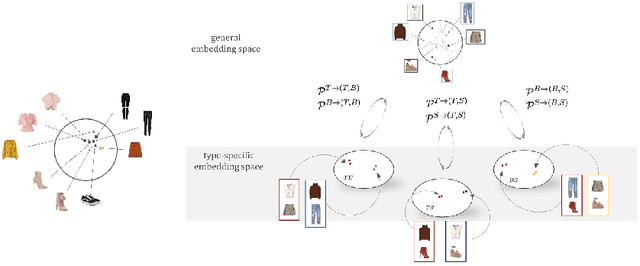

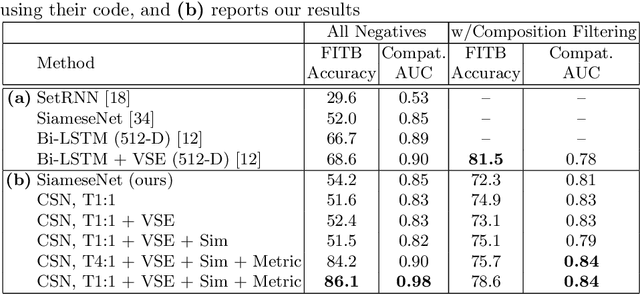
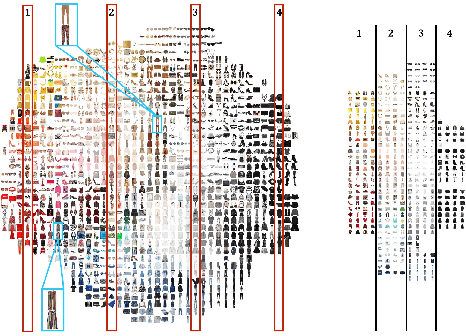
Outfits in online fashion data are composed of items of many different types (e.g. top, bottom, shoes) that share some stylistic relationship with one another. A representation for building outfits requires a method that can learn both notions of similarity (for example, when two tops are interchangeable) and compatibility (items of possibly different type that can go together in an outfit). This paper presents an approach to learning an image embedding that respects item type, and jointly learns notions of item similarity and compatibility in an end-to-end model. To evaluate the learned representation, we crawled 68,306 outfits created by users on the Polyvore website. Our approach obtains 3-5% improvement over the state-of-the-art on outfit compatibility prediction and fill-in-the-blank tasks using our dataset, as well as an established smaller dataset, while supporting a variety of useful queries.
An Approximate Shading Model with Detail Decomposition for Object Relighting
Apr 20, 2018Zicheng Liao, Kevin Karsch, Hongyi Zhang, David Forsyth




We present an object relighting system that allows an artist to select an object from an image and insert it into a target scene. Through simple interactions, the system can adjust illumination on the inserted object so that it appears naturally in the scene. To support image-based relighting, we build object model from the image, and propose a \emph{perceptually-inspired} approximate shading model for the relighting. It decomposes the shading field into (a) a rough shape term that can be reshaded, (b) a parametric shading detail that encodes missing features from the first term, and (c) a geometric detail term that captures fine-scale material properties. With this decomposition, the shading model combines 3D rendering and image-based composition and allows more flexible compositing than image-based methods. Quantitative evaluation and a set of user studies suggest our method is a promising alternative to existing methods of object insertion.
Detecting Anomalous Faces with 'No Peeking' Autoencoders
Feb 15, 2018Anand Bhattad, Jason Rock, David Forsyth
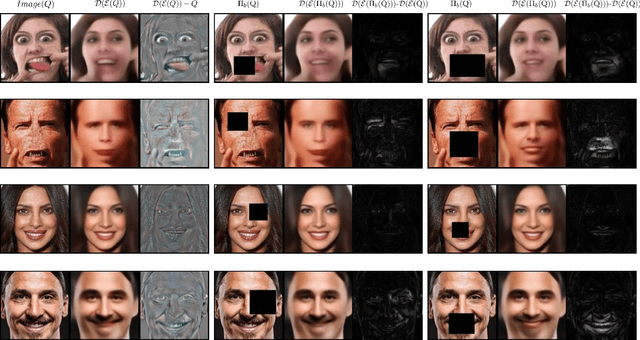
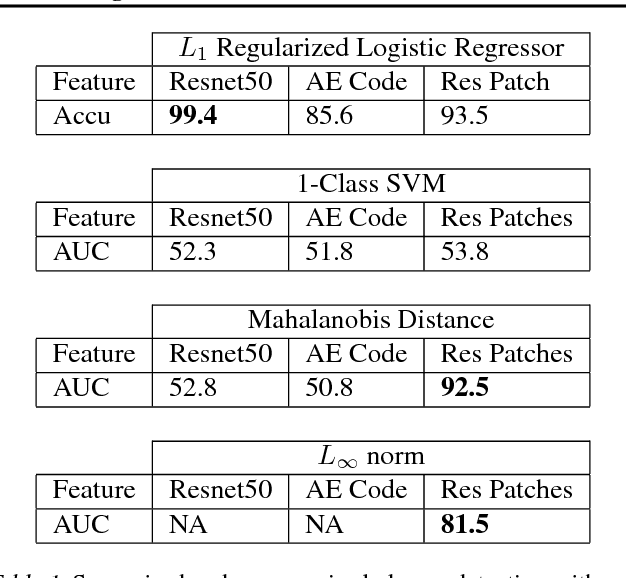
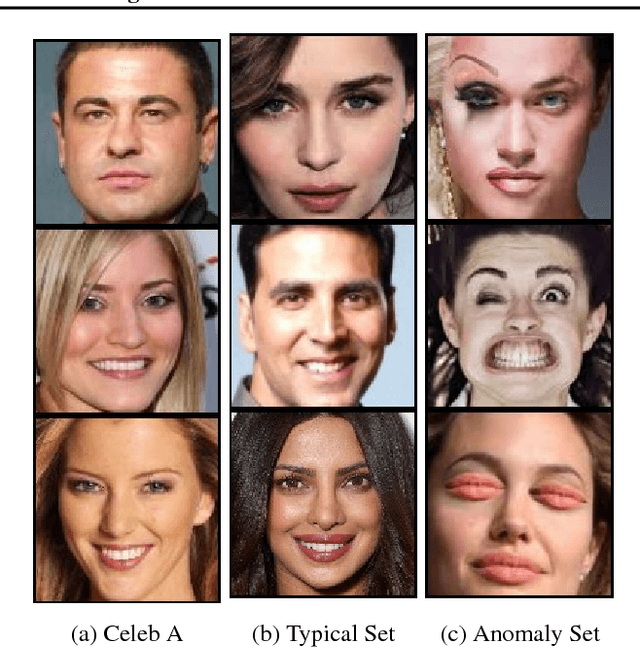
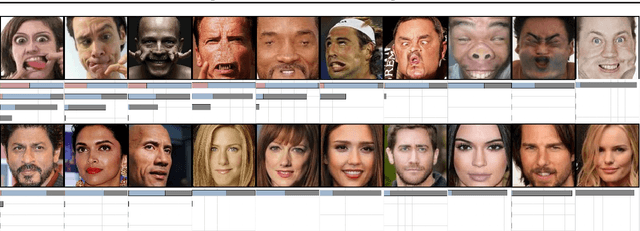
Detecting anomalous faces has important applications. For example, a system might tell when a train driver is incapacitated by a medical event, and assist in adopting a safe recovery strategy. These applications are demanding, because they require accurate detection of rare anomalies that may be seen only at runtime. Such a setting causes supervised methods to perform poorly. We describe a method for detecting an anomalous face image that meets these requirements. We construct a feature vector that reliably has large entries for anomalous images, then use various simple unsupervised methods to score the image based on the feature. Obvious constructions (autoencoder codes; autoencoder residuals) are defeated by a 'peeking' behavior in autoencoders. Our feature construction removes rectangular patches from the image, predicts the likely content of the patch conditioned on the rest of the image using a specially trained autoencoder, then compares the result to the image. High scores suggest that the patch was difficult for an autoencoder to predict, and so is likely anomalous. We demonstrate that our method can identify real anomalous face images in pools of typical images, taken from celeb-A, that is much larger than usual in state-of-the-art experiments. A control experiment based on our method with another set of normal celebrity images - a 'typical set', but nonceleb-A are not identified as anomalous; confirms this is not due to special properties of celeb-A.
Standard detectors aren't (currently) fooled by physical adversarial stop signs
Oct 26, 2017Jiajun Lu, Hussein Sibai, Evan Fabry, David Forsyth
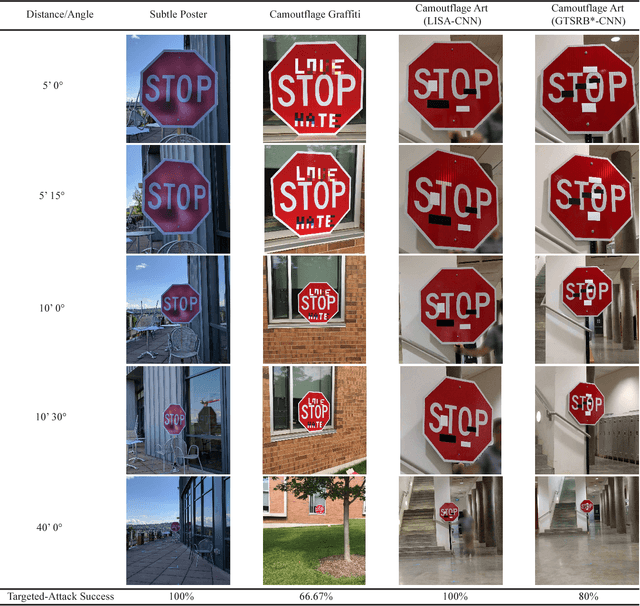
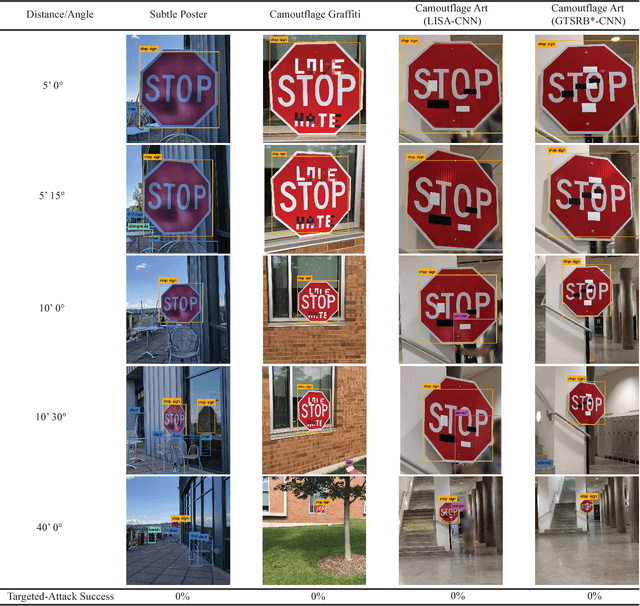
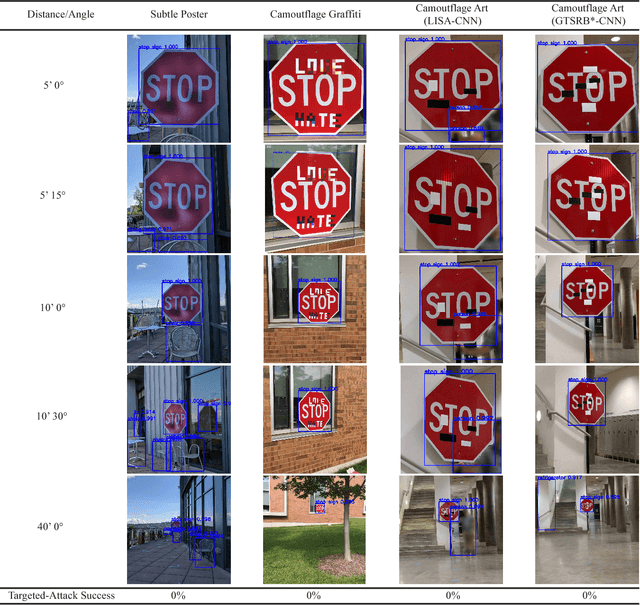
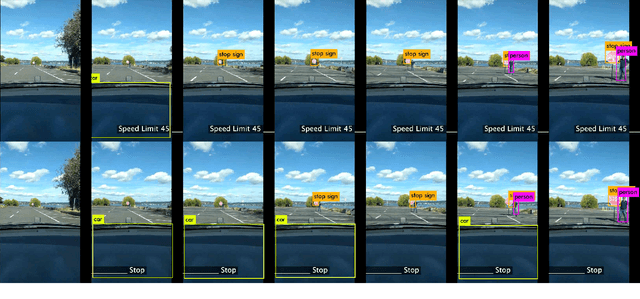
An adversarial example is an example that has been adjusted to produce the wrong label when presented to a system at test time. If adversarial examples existed that could fool a detector, they could be used to (for example) wreak havoc on roads populated with smart vehicles. Recently, we described our difficulties creating physical adversarial stop signs that fool a detector. More recently, Evtimov et al. produced a physical adversarial stop sign that fools a proxy model of a detector. In this paper, we show that these physical adversarial stop signs do not fool two standard detectors (YOLO and Faster RCNN) in standard configuration. Evtimov et al.'s construction relies on a crop of the image to the stop sign; this crop is then resized and presented to a classifier. We argue that the cropping and resizing procedure largely eliminates the effects of rescaling and of view angle. Whether an adversarial attack is robust under rescaling and change of view direction remains moot. We argue that attacking a classifier is very different from attacking a detector, and that the structure of detectors - which must search for their own bounding box, and which cannot estimate that box very accurately - likely makes it difficult to make adversarial patterns. Finally, an adversarial pattern on a physical object that could fool a detector would have to be adversarial in the face of a wide family of parametric distortions (scale; view angle; box shift inside the detector; illumination; and so on). Such a pattern would be of great theoretical and practical interest. There is currently no evidence that such patterns exist.
SafetyNet: Detecting and Rejecting Adversarial Examples Robustly
Aug 15, 2017Jiajun Lu, Theerasit Issaranon, David Forsyth
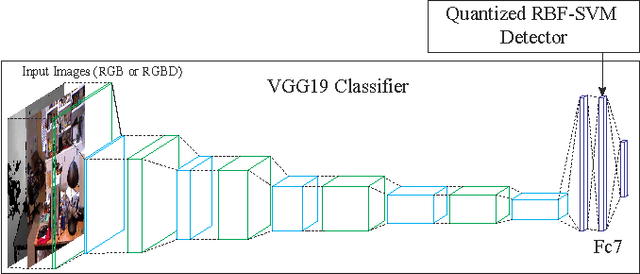

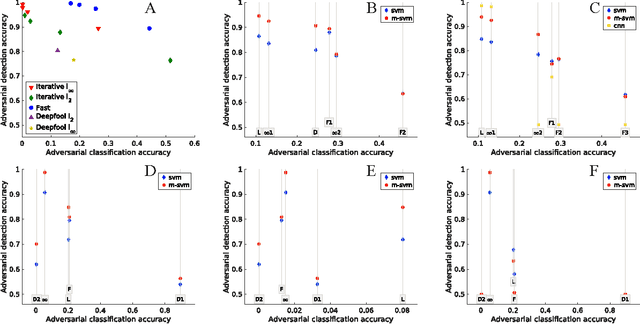

We describe a method to produce a network where current methods such as DeepFool have great difficulty producing adversarial samples. Our construction suggests some insights into how deep networks work. We provide a reasonable analyses that our construction is difficult to defeat, and show experimentally that our method is hard to defeat with both Type I and Type II attacks using several standard networks and datasets. This SafetyNet architecture is used to an important and novel application SceneProof, which can reliably detect whether an image is a picture of a real scene or not. SceneProof applies to images captured with depth maps (RGBD images) and checks if a pair of image and depth map is consistent. It relies on the relative difficulty of producing naturalistic depth maps for images in post processing. We demonstrate that our SafetyNet is robust to adversarial examples built from currently known attacking approaches.
NO Need to Worry about Adversarial Examples in Object Detection in Autonomous Vehicles
Jul 12, 2017Jiajun Lu, Hussein Sibai, Evan Fabry, David Forsyth

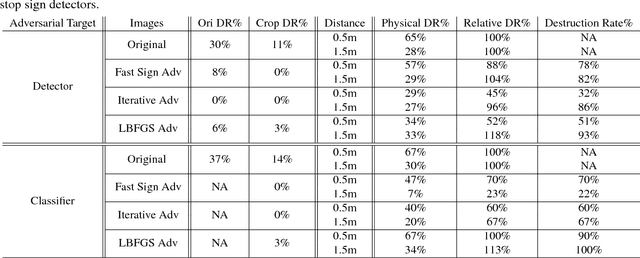

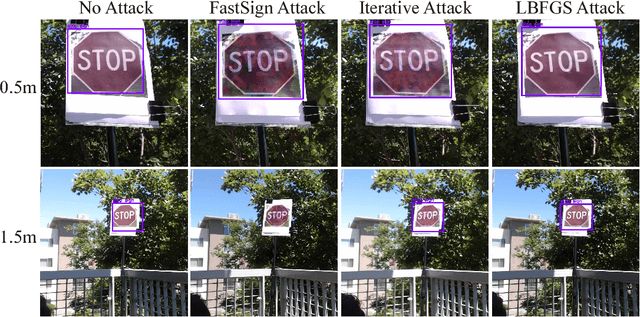
It has been shown that most machine learning algorithms are susceptible to adversarial perturbations. Slightly perturbing an image in a carefully chosen direction in the image space may cause a trained neural network model to misclassify it. Recently, it was shown that physical adversarial examples exist: printing perturbed images then taking pictures of them would still result in misclassification. This raises security and safety concerns. However, these experiments ignore a crucial property of physical objects: the camera can view objects from different distances and at different angles. In this paper, we show experiments that suggest that current constructions of physical adversarial examples do not disrupt object detection from a moving platform. Instead, a trained neural network classifies most of the pictures taken from different distances and angles of a perturbed image correctly. We believe this is because the adversarial property of the perturbation is sensitive to the scale at which the perturbed picture is viewed, so (for example) an autonomous car will misclassify a stop sign only from a small range of distances. Our work raises an important question: can one construct examples that are adversarial for many or most viewing conditions? If so, the construction should offer very significant insights into the internal representation of patterns by deep networks. If not, there is a good prospect that adversarial examples can be reduced to a curiosity with little practical impact.
 Add to Chrome
Add to Chrome Add to Firefox
Add to Firefox Add to Edge
Add to Edge